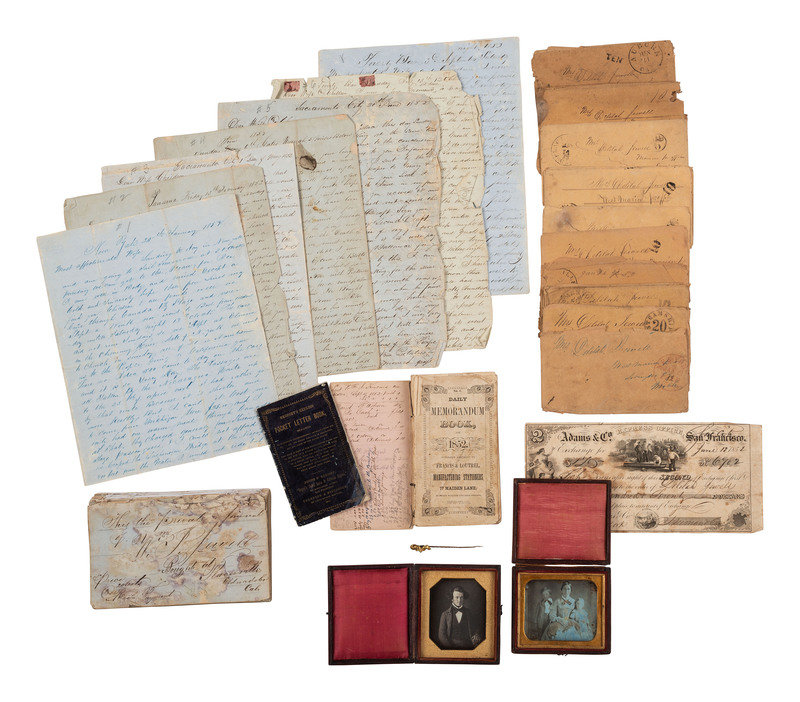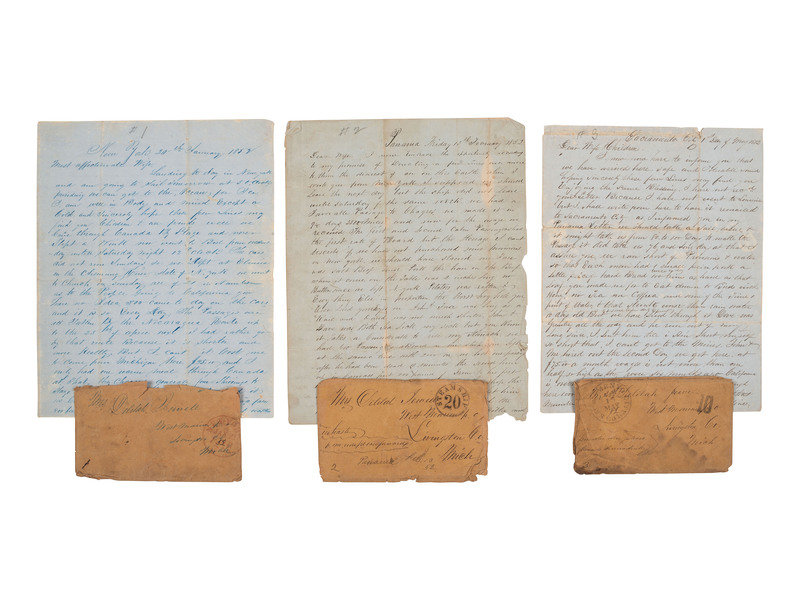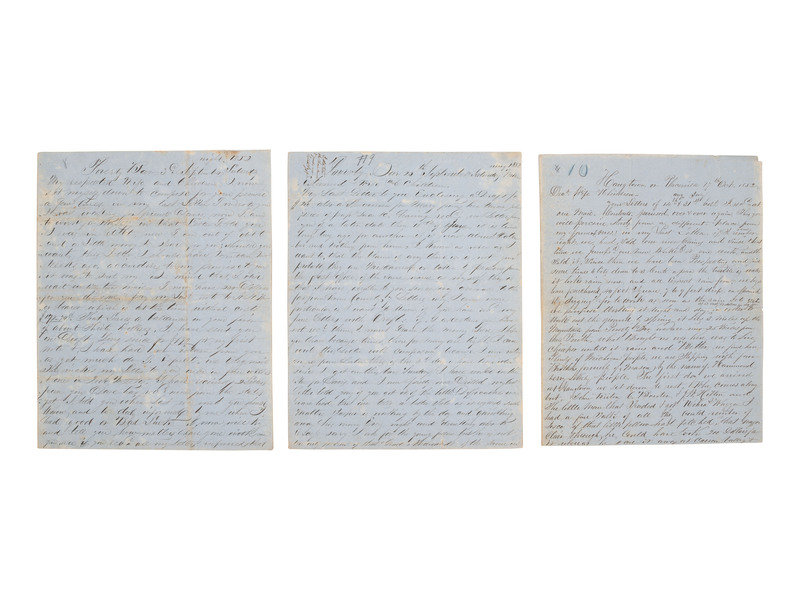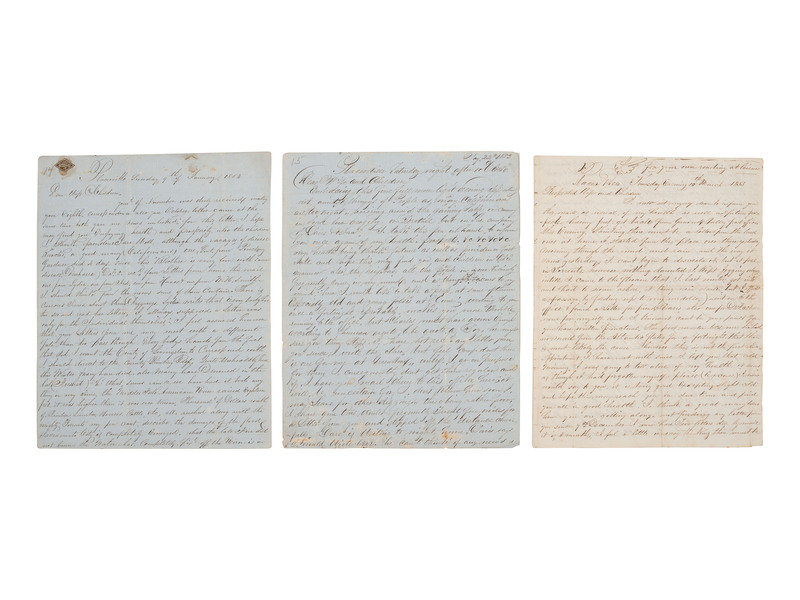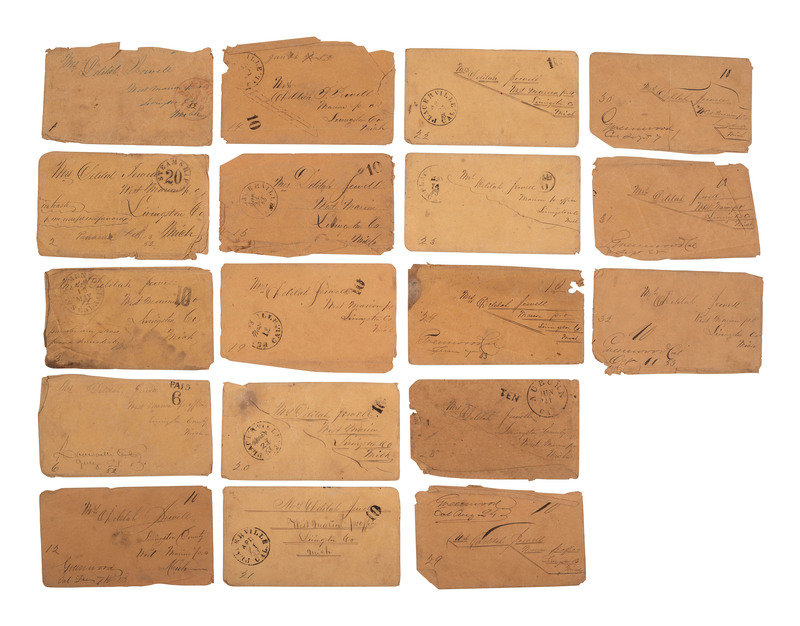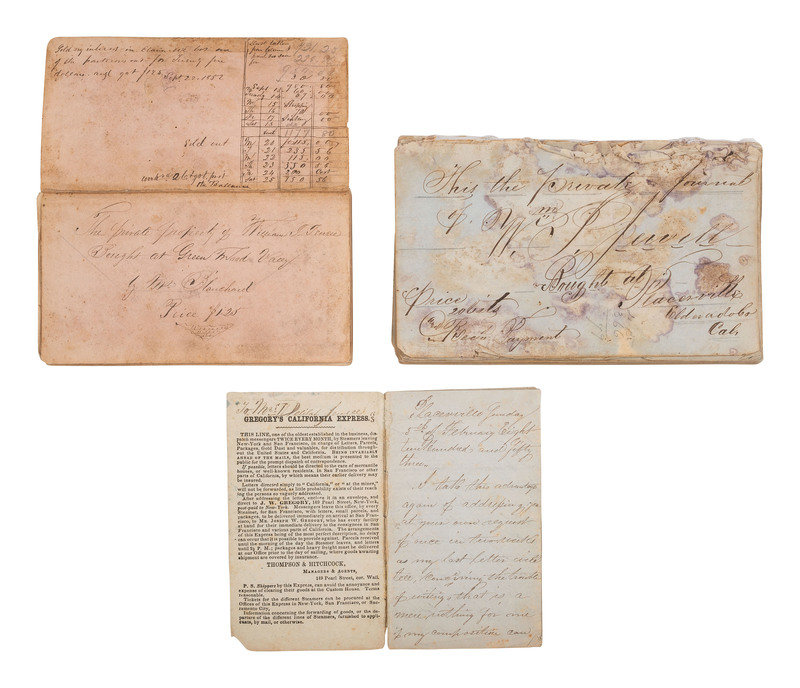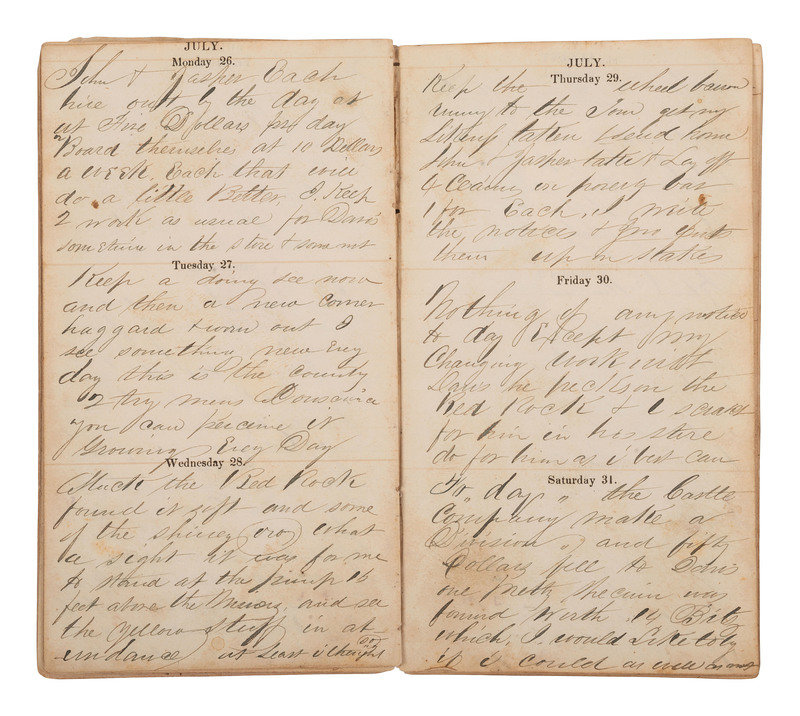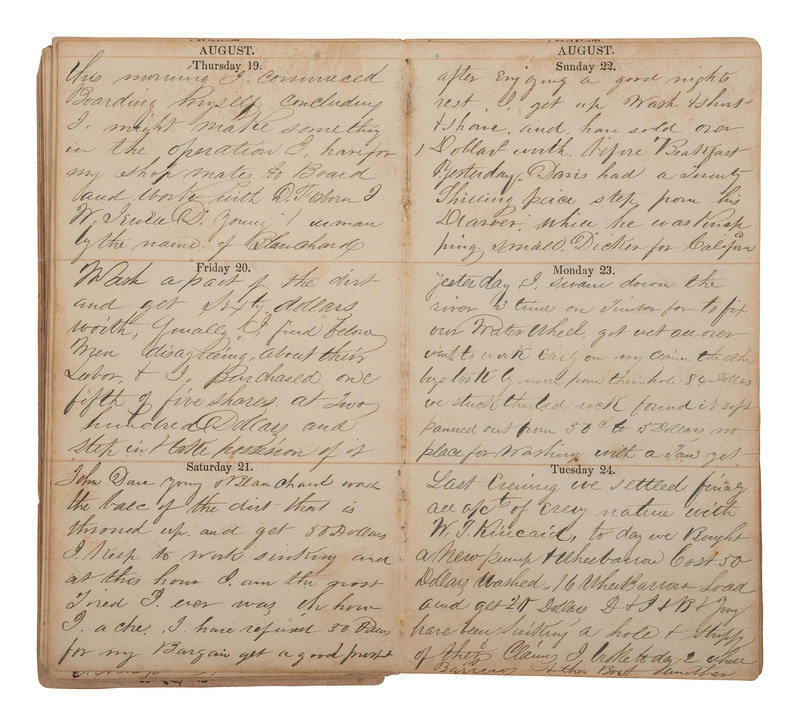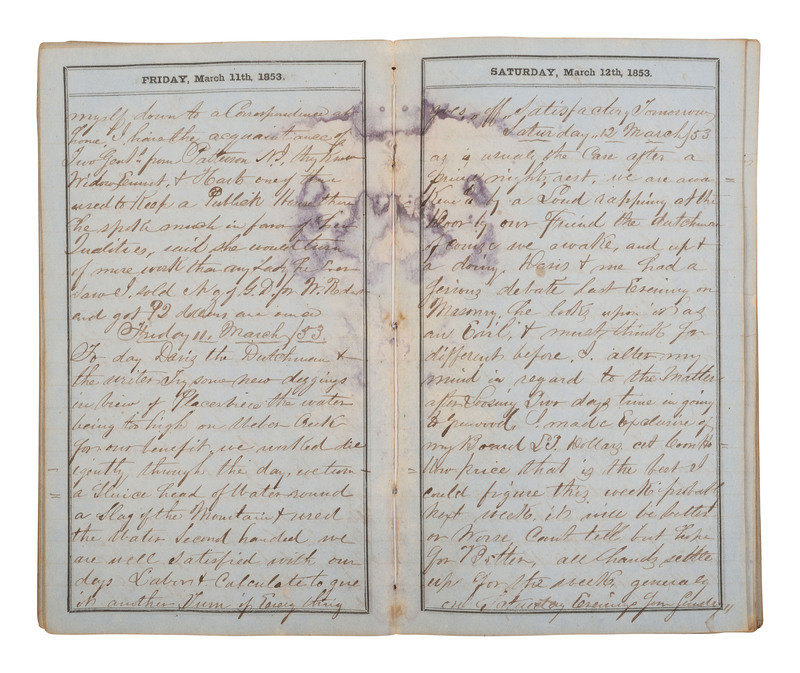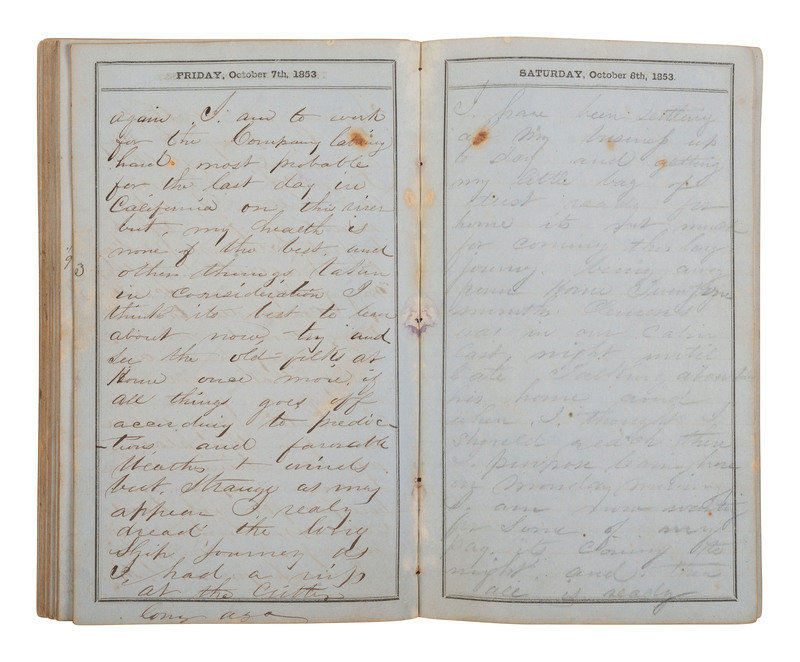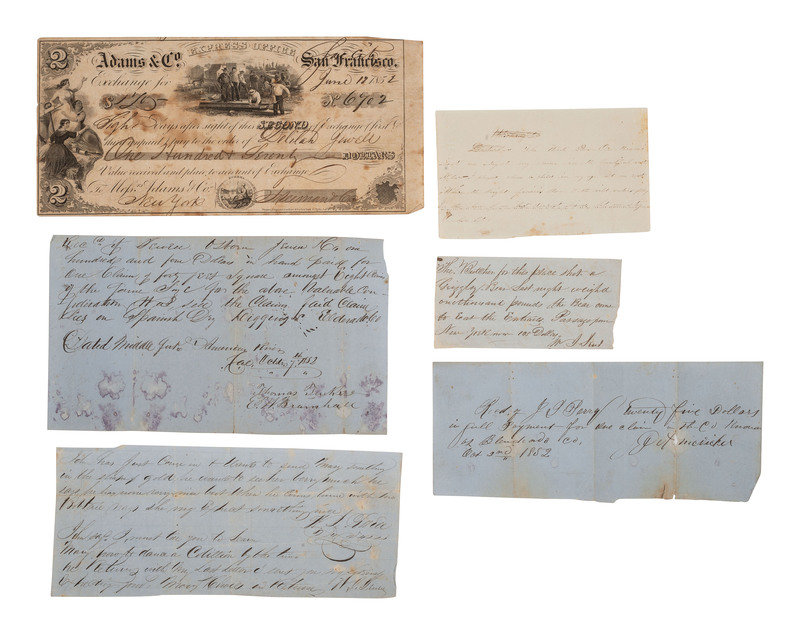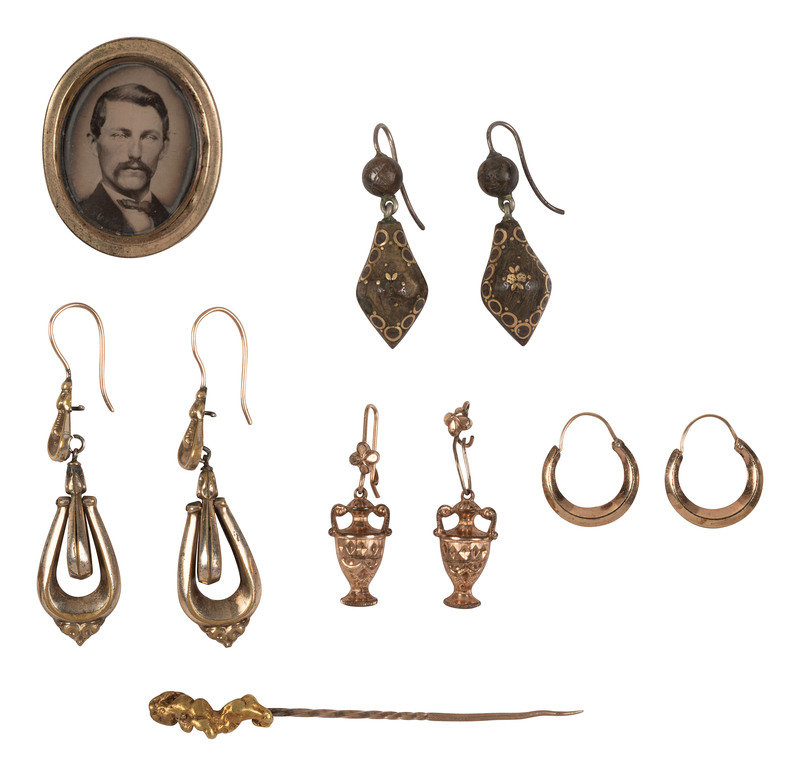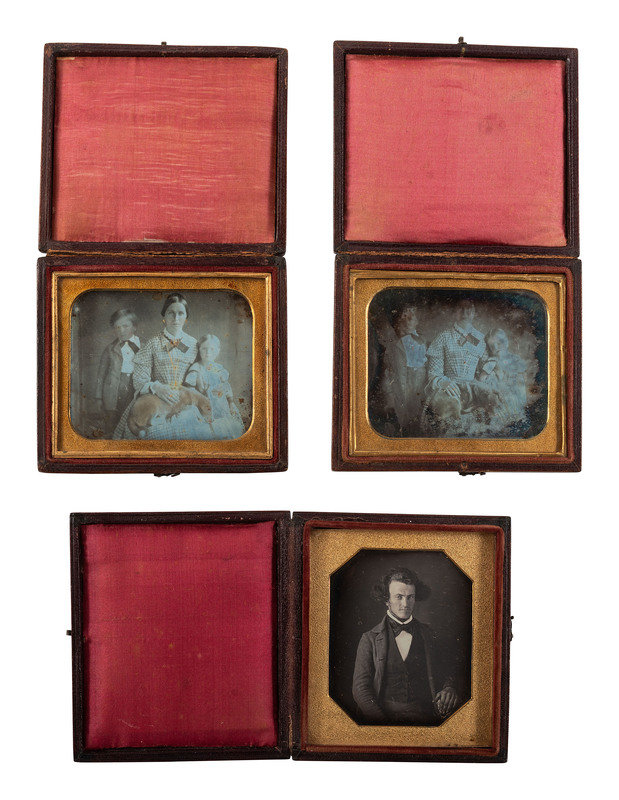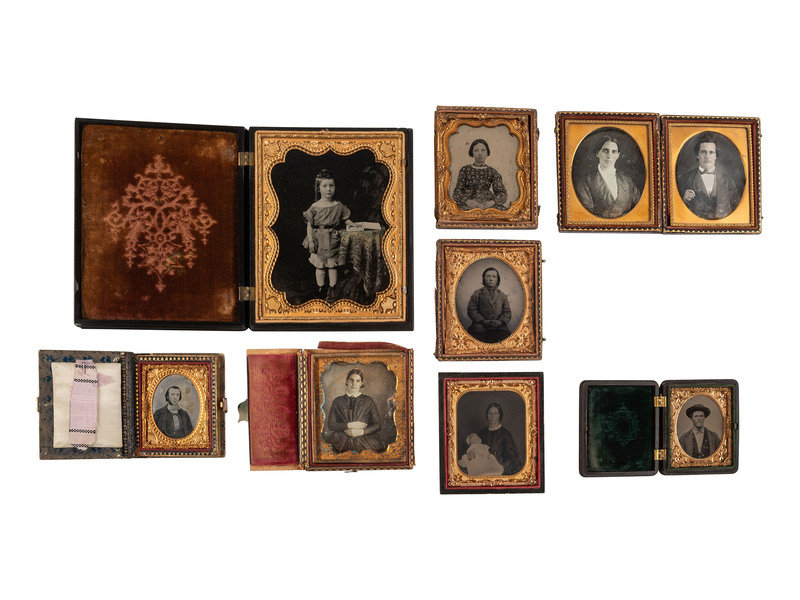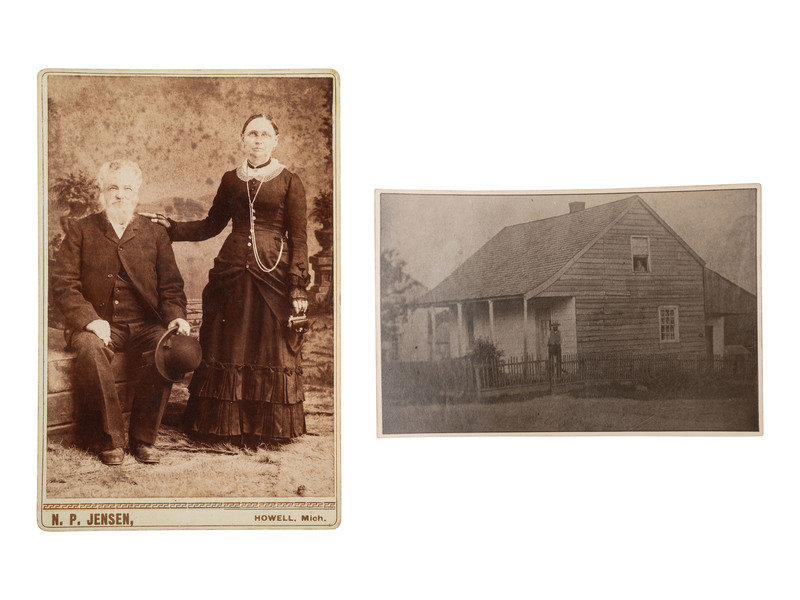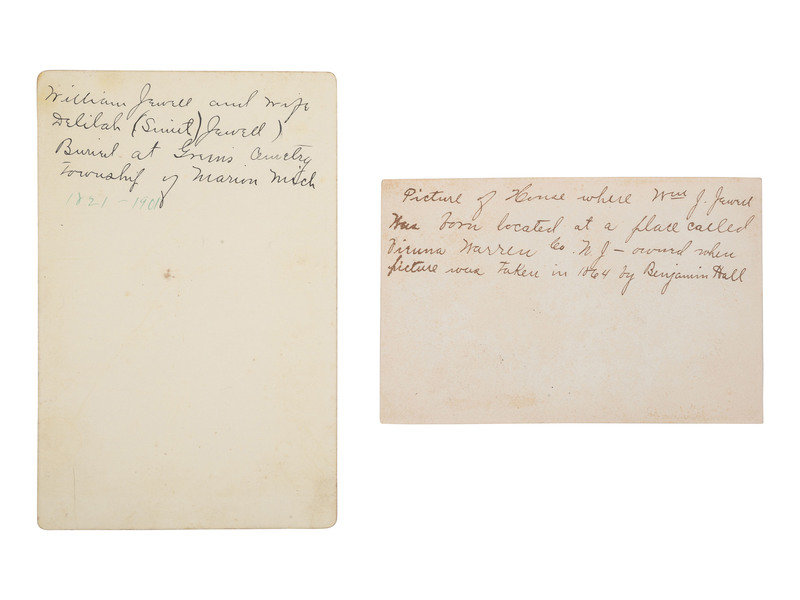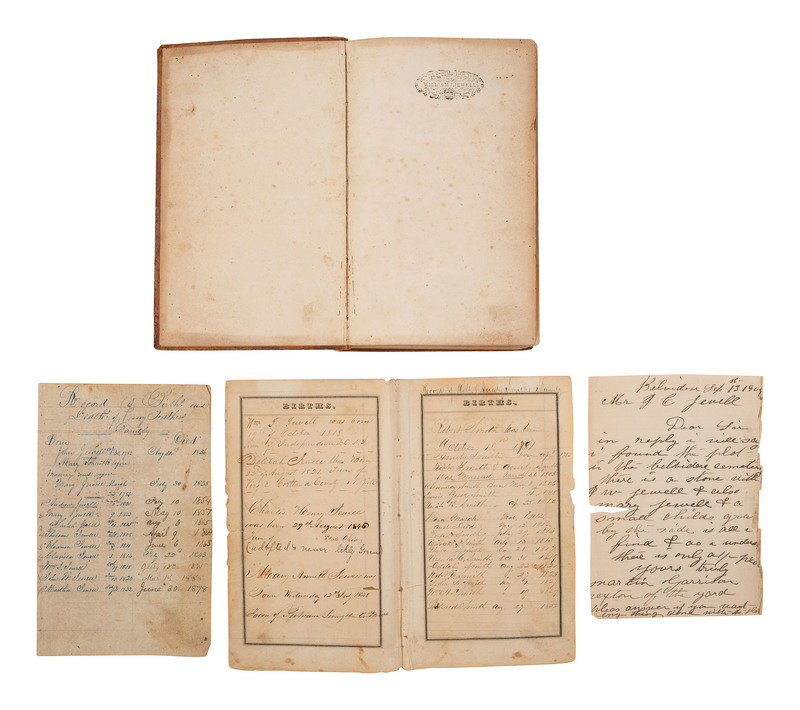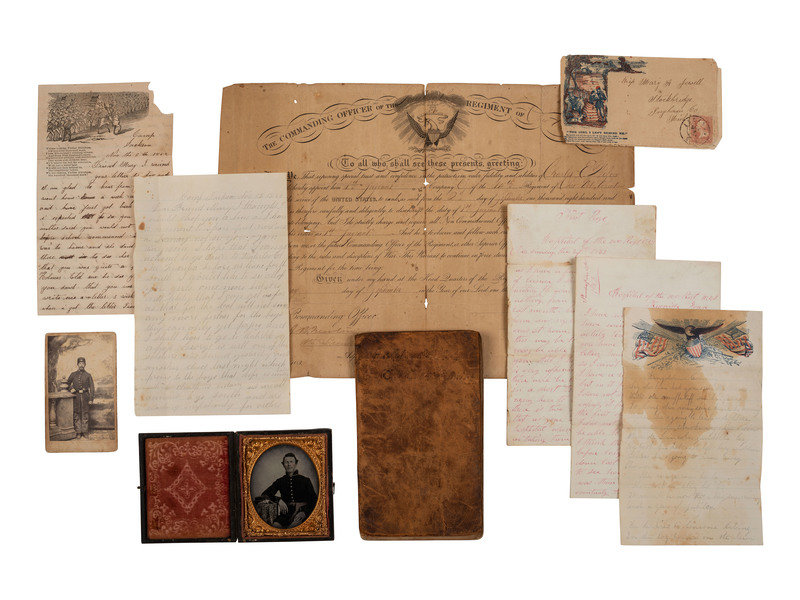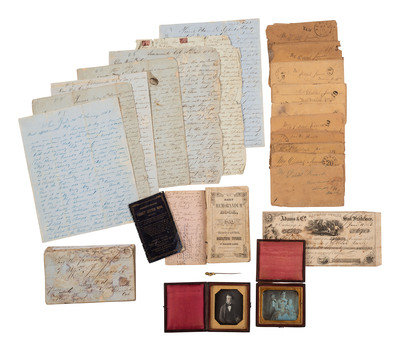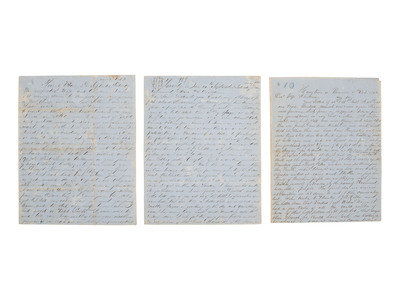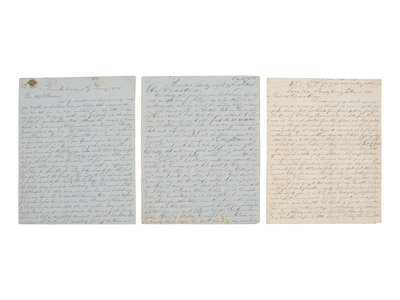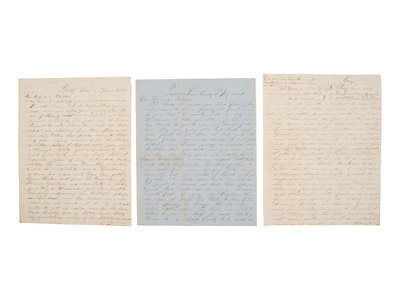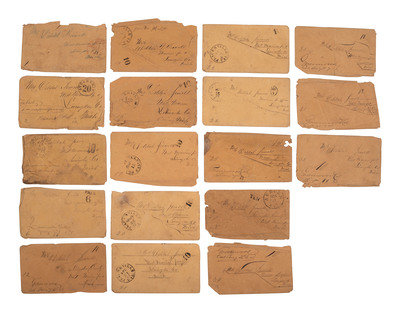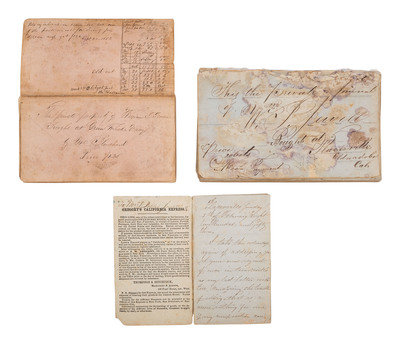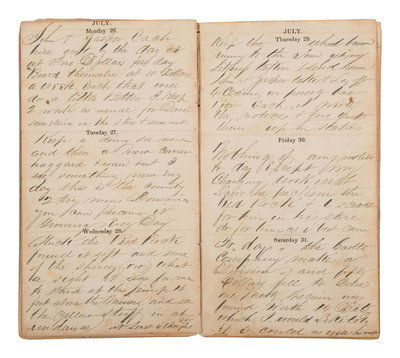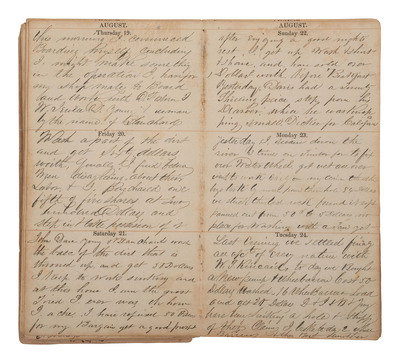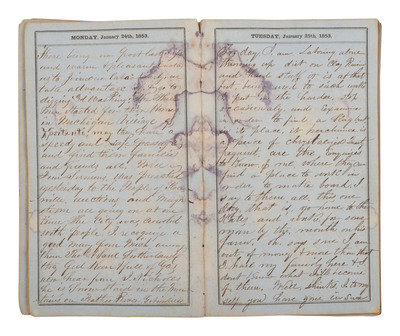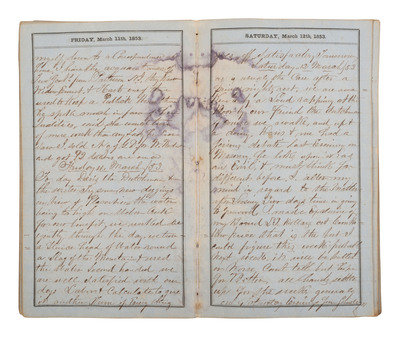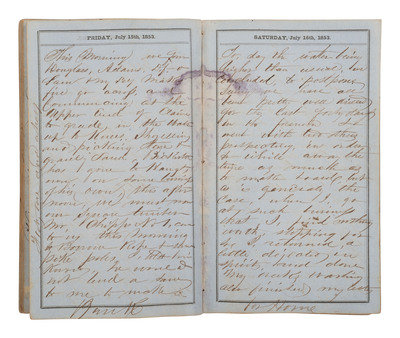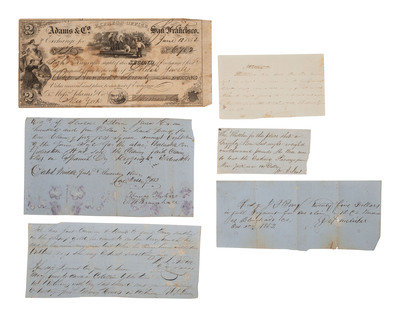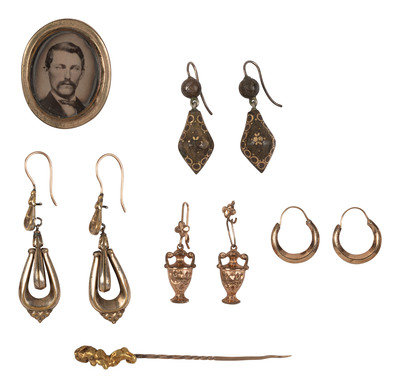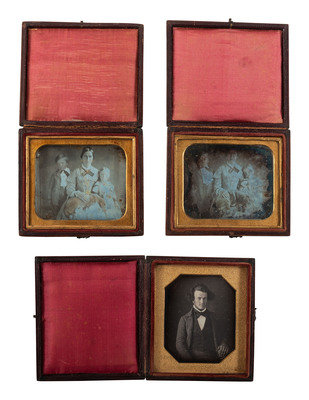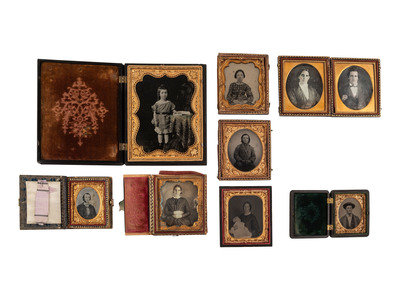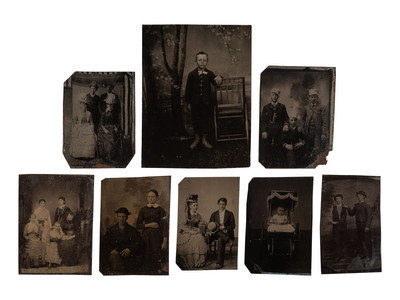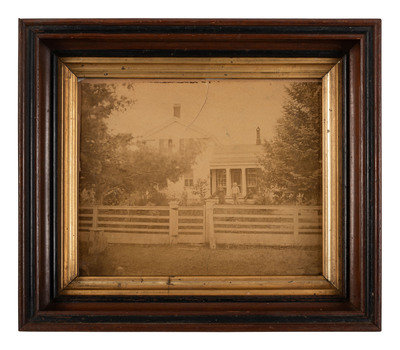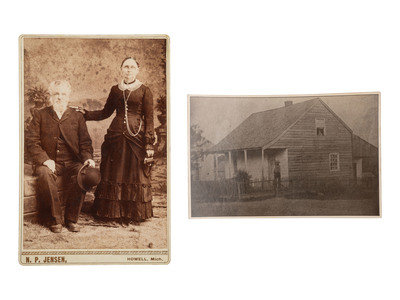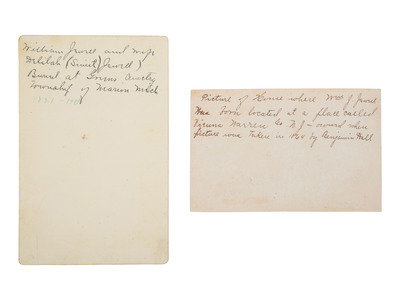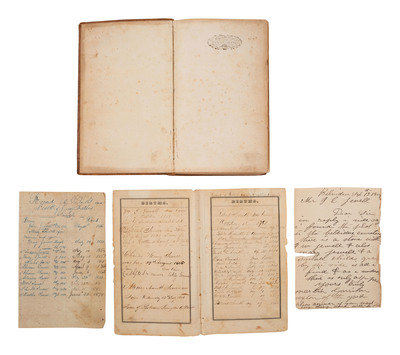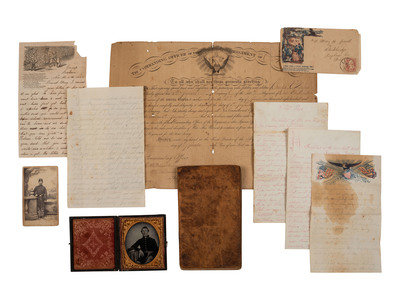Lot 324
[GOLD RUSH]. Extensive California Gold Rush archive of William J. Jewell (1818-1885) including letters, diaries, and photographs, ca. 1852-1853.
Sale 1250 - American Historical Ephemera & Photography
Nov 30, 2023
10:00AM ET
Live / Cincinnati
Own a similar item?
Estimate
$15,000 -
25,000
Price Realized
$34,650
Sold prices are inclusive of Buyer’s Premium
Lot Description
[GOLD RUSH]. Extensive California Gold Rush archive of William J. Jewell (1818-1885) including letters, diaries, and photographs, ca. 1852-1853.
30 letters written by gold prospector William J. Jewell to his wife Delilah Smith Jewell (1821-1901) spanning January 1852 - October 1853, accompanied by 18 corresponding covers many of which bear circular datestamps from early California settlements (letters in generally good condition with expected wear given age, some letters with small losses, toning and minor dampstaining affecting text, creasing; covers toned and worn, some with small losses); 2 diaries, the first a "Daily Memorandum Book, for 1852" featuring 3 entries per page, 3 1/4 x 5 3/4 in., 126pp, with daily entries spanning 1 January 1852 - 31 December 1852 and additional notations on end pages (no cover, string binding partially unbound and some loose pages), the second diary featuring 1 entry per page, 4 x 6 3/4 in., 326pp, with daily entries spanning 1 January 1853 - 23 November 1853 (no cover, loose pages, dampstaining sometimes affecting text though entries generally all remain legible); "Gregory's Express Pocket Letter Book," 2 7/8 x 4 7/8 in., 40pp, comprising a letter written by Jewell to his wife from Placerville, 5 February 1852; a large group of family photographs including cased images, CDVs, tintypes, and paper photographs; and additional Gold Rush-era ephemera and correspondence.
AN EXTRAORDINARY CALIFORNIA GOLD RUSH ARCHIVE, AND ONE OF THE LARGEST EVER TO COME TO MARKET
William J. Jewell departed for California on 12 January 1852. The earliest of the two diaries offered here records his departure, Jewell noting the day prior that he "felt rather dull but kept up courage." On the 12th he departed Michigan with his brother John W. Jewell and brother-in-law David F. Osborn: "Myself, D. Osborn & my Bro John started on foot on our mission, snow Nine deep[.] bid adieu to them that was near to me, and Mary my daughter Lie a Sleeping[.] how I feel when I think of my home[.] we got to Detroit this day by stage." So begins Jewell's nearly two-year "mission" as a "Forty-Niner," an adventure which he recorded with astonishing detail and regularity throughout his absence. While Jewell's letters provide an overview of his time as a Forty-Niner, his diaries offer a remarkable day-by-day accounting of his labors and experiences in the gold fields.
Jewell's earliest letters and diary entries are notable for his descriptions of the arduous journey undertaken just to make it to the gold fields, and are illustrative of the unprecedented mass migration that was underway. His first letter home is written from New York City on 20 January 1852. He describes his journey to New York from Livingston County, Michigan, traversing Canada via stage, then crossing the suspension bridge at Niagara Falls, New York ("I never in all my Life was so Badly Frightened"), then taking rail cars through Elmira and on to New York City. Jewell indicates that he has encountered many on their way to the gold fields ("500 came today on the cars and and it is so Every Day"), as well as those returning from the gold fields ("some Tell us we are fools some say we can do well"). He then continues indicating the route he has chosen ("Passage by the old route Chagres & Panama" as opposed to the "Nicaragua Route" which was booked solid for months). On 13 February 1852 Jewell writes his second letter home, this time from Panama. He says he "should have starved" in steerage had they not purchased provisions in New York, then describes the often treacherous journey from Chagres, through the Panama jungle, and to Panama City, before setting sail for California. His third letter, dated 1 May 1852, was written from Sacramento City following a difficult 76-day sailing voyage. "California is overrun with people," he writes, "to Day they come through here 1000 from China and probably twice that number from the States. no person would Believe The Emigration to this Country untill they saw it...." Sacramento City itself is a wonder to this small-town Michigan farmer. Jewell writes to Delilah the following month describing "the sports of a Sunday" including two men fighting for a $1,000 prize, horse races, and a fight between a grizzly bear chained to a post and a Spanish bull. Other amusements include auction sales, theatres, a circus, and gambling ("by women as well as men"). Hangings are common ("an Every day occurrence") and gold is abundant ("you can go in many places here and see Bushels of 50 Dollar peices of Gold"). Jewell, however, is unable to afford a journey to the mines and the purchase of equipment upon arrival in Sacramento, so he hires himself out as a laborer for a monthly wage of $75.
By July 1852 Jewell at last earned enough money to leave Sacramento. He writes on 13 July [1852], from Poverty Bar, located on the Middle Fork of the American River in the foothills of the Sierra Nevada, indicating that he is now working with William Davis, Jr. Census records indicate that Davis had ties to Livingston County, Michigan. Davis operated a provision store at Poverty Bar, and correspondence indicates that he was someone with whom both William and John Jewell were already well-acquainted. Jewell describes for Delilah his new occupation: "The Miners work from 6 o'clock to 11 then rest until half past one then work until 1/2 past 6." Adding later a sentiment he repeats throughout his journals, "I thought I knew what hard Labor was but I did not untill I commenced mining." He describes the ins-and-outs of being a miner, including purchasing claims by the month and purchasing tools, where the gold deposits are to be found, and more. He indicates that he is working with David Osborn at Poverty Bar, and that his brother John proceeded up 20 miles further to begin speculating. Notably, Jewell references in this same letter (as well as others) the enclosure of a small specimen, possibly the 4.7 gram gold piece that is attached to a stick pin and accompanies the lot. Also of note is Jewell's request for Delilah to "go with the children...& get yours & theirs miniature Pt [photograph or portrait] taken together in one frame or case...and mail them to Louisville Greenwood Valley post office Elderado Co. Cal...." Delilah presumably complied, as two sixth plate images of Delilah and the children, Charles Henry Jewell (1845-1915) and Mary Annett Jewell (1848-1862), accompany the lot.
From July 1852 through October 1853 Jewell continues writing to Delilah while also making daily diary entries documenting his time as a prospector predominantly in Poverty Bar. Alternating between working directly on his claims, hiring himself out to work other claims, and working in Davis's provision store, Jewell soon develops knowledge and skills essential to his work as a miner. Sample diary entries (retaining original punctuation and spelling) include the following:
23 August 1852: "Yesterday I swam down the river 3 times on Timber for to fix our Water Wheel got wet all over went to work early on my claim the other boys back by noon from their hole 84 dollars we struck the bed rock found it soft panned out from 50 cents to 5 Dollars no place for washing with a Tom yet."
9 January 1853 (letter to Delilah from Placerville): "Quite unhealthy here this Winter Many have died, also many have Drowned...oh What snows, rain, & c we have had it beats anything in my Time. the Middle Fork American River raised Eighteen feet, it was higher than it was ever known, Thousands of Dollars worth of Timber, Lumber, Houses, Cattle, etc, all rushed along with the mighty Torrents my pen cant describe the damages of the flood. Sacramento City is completely emerged, what the late Fire did not burn the Water has completely fixt...in the City the Water in stores is from 2 to 6 feet Deep a customer gets rowed in a boat in the store, eats & pays his Dollars...."
31 March 1853: "We are up in the morning soon as we expect to pay for a head of water, and a little after sunrise we are on the ground there we wait with patience with sluices set and tom waiting patiently expecting every minute when the Water will come rushing down the mountain stop there until near noon finally one of us goes up on the Mountain to ascertain if possible when if not to day can we be accommodated with a Head. The Waterman say Tomorrow There then is Another day but, that I can't Earn a dime...."
16 April 1853: "This morning I hired myself out to work for a Company of Three men for Three Dollars for to day & about noon they thought they were not making a terrible fortune one proposed for me to pay my portion of the water and share accordingly I told them I would we kept working a pretty good jog till after sundown. we then pannd out and in Cleaning up the Sluice I showed them a specimen 'oh' says one we will pay you by the day, no I replied you don't, but says I i'll give to the Company one bit more than any man in Hangtown and they are all agreed to the proposal...."
4 July 1853: "Independence day by the reports of Guns, Rocks, and Logs, all are sending their powder Messengers abroad no accidents by bursting of Canons. on this Bar Some have gone to Auburn, some to Hangtown and others celebrate on the Bar. some are swimming in the River but four of our Company are Framing Timbers the only Co. working to day for Dinner our Hostess gave us potatoe, squash, Roast beef, cranberry Tart, Sauce Do. Bread & Butter, Cake with frosting and a Quaking pudding cake looked very nice the Pudding was Excellent."
8 August 1853: "I attended a Meeting of the River men and heard the bye Laws of them read, etc. Tomorrow one from Each Co. go to stake the low water mark from the bank diggers also to ascertain if each flume is ever posted underneath of & material good & c. I got my foot badly hurt today D.F.O. let a board fall four feet on it and it hurt me very much so I can't walk to the valley to day."
7-8 October 1853: "again I am to work for the Company laboring hard most probably for the last day in California on this river but my health is none of the best and other things taken into consideration I think its best to leave about now...I have been settling all my business up to day and getting my little bag of dust ready for home its not much for coming this long journey being away from home Twenty-one months."
Between Jewell's letters and diaries, and additional correspondence from John W. Jewell, the archive includes references to multiple claim locations and notable early Gold Rush locales including "McDowel Hill," "Hangtown" (later known as Placerville), "Poverty Bar," "Greenwood," "Mormon Island," "Roads Digins," "Louisville," "Spanish Dry Digings," and more. William Jewell provides details on his travels, the people he encounters, food, terrain, mail, transportation, leisure activities, mining camps, and the everyday life of a miner. He provides clear testimony to the difficult nature of his labors, referencing injuries, freezing cold rivers, equipment that often needs to be repaired or replaced, and water that is too high or alternately river beds that are too dry. He records expenses for boarding, travel from one mining operation to another, and for provisions, while also recording his earnings and the use of gold and gold dust as currency. Jewell is well aware of the fickle nature of luck, often referring to the rising and falling fortunes of his fellow prospectors. In the gold fields unlucky men not only lose fortunes, but as Jewell recorded many lose their lives from illnesses such as dysentery and small pox. Ultimately, Jewell endured the hardships of a miner's life with fortitude and pragmatism before determining in the fall of 1853 that it was time to return home. He departed California on 16 October 1853, and arrived in Michigan approximately seven weeks later.
[With:] A large group of photographs, predominantly consisting of portraits, some identified as members of the Jewell family as well as other relations from both William Jewell and Delilah Smith Jewell's extended families. Photography includes more than 20 cased images, highlighted by a sixth plate daguerreotype portrait of William J. Jewell dressed in a white dress shirt, vest, and coat, ca 1850s; two sixth plate daguerreotypes featuring Delilah Jewell, her two children, Charles Jewell and Mary Jewell, and a dog, ca 1852; and a half plate ambrotype (period crack and repair) of Martha "Mattie" Horton Jewell (1868-1960), wife of William and Delilah's third child Fobes C. Jewell (1864-1932). -- Additional photography includes more than 30 tintypes, 10 CDVs, and a cabinet card featuring a seated gentleman with white hair and a woman standing by his side, inscribed on verso "William Jewell and Wife Delilah (Smith) Jewell / Burial at Green's Cemetery Township of Marion Mich." -- One framed albumen photograph, approx. 9 1/2 x 7 3/4 in. (sight), features William and Delilah Jewell posed in front of their Michigan home, ca 1870s.
[With:] Additional Gold Rush correspondence and ephemera, including: three letters written by John W. Jewell; one letter written by William Davis, Jr.; an Adams & Co. draft for $170 sent by Jewell to Delilah from San Francisco, 12 June 1852; and two receipts for payments on claims, one being from William Jewell's company, "Recd of Jewell, Osborne, Jewell & Co. one hundred and four Dollars in hand paid for one claim of forty feet Square amongst Eight Claims...claim Lies on Spanish Dry Diggings Elderado Co. / Dated Middle fork American River / Cal. October 7 1852." --- A small gold nugget, approx. 3/4 in. in length, mounted to a stick pin. -- The Holy Bible. New York: American Bible Society, 1842. Ink-stamped "William J. Jewell" on front free end paper. -- Several documents recording births, deaths, and marriages in the Jewell and Smith families, including the births of William Jewell and Delilah Smith Jewell, and the births of their adopted son Charles Jewell and their biological daughter Mary Jewell. -- The Pet Annual, A Gift for All Seasons. New York: Leavitt and Allen, n.d. Inscribed to William Jewel's daughter, "Presented to Mary A. Jewell by James C. Ferguson." -- An assortment of 19th-century women's earrings. -- A small number of miscellaneous documents and other ephemera associated with the Smith and Jewell families and their descendants.
[Also with:] A small group of Civil War letters and ephemera, several of which are associated with Charles E. Wilcox, Ohio 14th Infantry. Also accompanied by two war-date images: a CDV standing portrait of an unidentified armed soldier, and a sixth plate ruby ambrotype portrait, ca 1861-62, of an older private wearing a nine-button infantry frock coat and a red tinted sash which was exclusive to officers, indicating it may have been a photographer's prop. HDS locates no records consistent with William J. Jewell of Michigan having served during the Civil War, though HDS indicates that his son Charles H. Jewell enlisted on 8/4/1861 as a Private with the Michigan 16th Infantry and served the duration of the war.
William J. Jewell was born in 1818 in Independence, Warren County, New Jersey, the 7th of 9 children. The History of Livingston County, Michigan (1880), indicates that he removed to Hillsdale County, Michigan, at the age of twenty-two. Two years later, ca 1842, he purchased eighty acres in Iosco, Michigan, and married Delilah Smith, originally of Virgil, Cortland County, New York. Other members of the Jewell family departed New Jersey for Michigan as well including William's younger brother John Waford Jewell (1820-1888), who is identified in the 1850 US Federal Census as residing at the home of William Jewell and engaging in agriculture alongside his brother. In 1852 William and John Jewell departed Michigan together for the California gold fields along with David F. Osborne (1824-1903), William Jewell's brother-in-law. Several other prospectors who seem to have Michigan ties, including William Davis, Jr., Charles Taylor, and David Young, are also identified in Jewell's writings exemplifying the ways in which large numbers of men from local communities departed for the gold fields, and the ways in which they remained connected while in California. With his health deteriorating, Jewell made the decision to return home in the fall of 1853. Census data indicates that Jewell returned to farming and spent the remainder of his life in Livingston County, Michigan. His 1885 obituary heralds "A Good Man Gone" and recalls his "successful visit to California," lamenting that "his death is the removal of one of the best known figures in the agricultural history of [Livingston] county."
See also Lot 325: Two daguerreotypes of miner William J. Jewell (1818-1885) in the California gold fields. [Poverty Bar, California], [29 July 1852].
This lot is located in Cincinnati.
Condition Report
Contact Information
Auction Specialist
